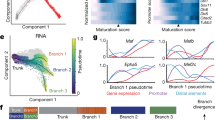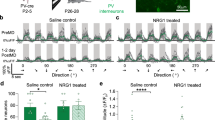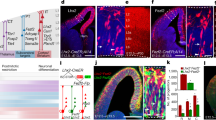Abstract
Cortical inhibitory circuits are formed by γ-aminobutyric acid (GABA)-secreting interneurons, a cell population that originates far from the cerebral cortex in the embryonic ventral forebrain. Given their distant developmental origins, it is intriguing how the number of cortical interneurons is ultimately determined. One possibility, suggested by the neurotrophic hypothesis1,2,3,4,5, is that cortical interneurons are overproduced, and then after their migration into cortex the excess interneurons are eliminated through a competition for extrinsically derived trophic signals. Here we characterize the developmental cell death of mouse cortical interneurons in vivo, in vitro and after transplantation. We found that 40% of developing cortical interneurons were eliminated through Bax (Bcl-2-associated X)-dependent apoptosis during postnatal life. When cultured in vitro or transplanted into the cortex, interneuron precursors died at a cellular age similar to that at which endogenous interneurons died during normal development. Over transplant sizes that varied 200-fold, a constant fraction of the transplanted population underwent cell death. The death of transplanted neurons was not affected by the cell-autonomous disruption of TrkB (tropomyosin kinase receptor B), the main neurotrophin receptor expressed by neurons of the central nervous system6,7,8. Transplantation expanded the cortical interneuron population by up to 35%, but the frequency of inhibitory synaptic events did not scale with the number of transplanted interneurons. Taken together, our findings indicate that interneuron cell death is determined intrinsically, either cell-autonomously or through a population-autonomous competition for survival signals derived from other interneurons.
This is a preview of subscription content, access via your institution
Access options
Access to this article via Institution of Civil Engineers Library is not available.
Subscribe to this journal
Receive 51 print issues and online access
$199.00 per year
only $3.90 per issue
Buy this article
- Purchase on SpringerLink
- Instant access to full article PDF
Prices may be subject to local taxes which are calculated during checkout




Similar content being viewed by others
References
Buss, R. R., Sun, W. & Oppenheim, R. W. Adaptive roles of programmed cell death during nervous system development. Annu. Rev. Neurosci. 29, 1–36 (2006)
Oppenheim, R. W. Cell death during development of the nervous system. Annu. Rev. Neurosci. 14, 453–501 (1991)
Hamburger, V. & Levi-Montalcini, R. Proliferation, differentiation and degeneration in the spinal ganglia of the chick embryo under normal and experimental conditions. J. Exp. Zool. 111, 457–501 (1949)
Levi-Montalcini, R. The development of the acoustico-vestibular centers in the chick embryo in the absence of the afferent root fibers and of descending fiber tracts. J. Comp. Neurol. 91, 209–241 (1949)
Boya, P. & De la Rosa, E. J. Cell death in early neural life. Birth Defects Res. 75, 281–293 (2005)
Nikoletopoulou, V. et al. Neurotrophin receptors TrkA and TrkC cause neuronal death whereas TrkB does not. Nature 467, 59–64 (2010)
Polleux, F., Whitford, K. L., Dijkhuizen, P. A., Vitalis, T. & Ghosh, A. Control of cortical interneuron migration by neurotrophins and PI3-kinase signaling. Development 129, 3147–3160 (2002)
Gorba, T. & Wahle, P. Expression of TrkB and TrkC but not BDNF mRNA in neurochemically identified interneurons in rat visual cortex in vivo and in organotypic cultures. Eur. J. Neurosci. 11, 1179–1190 (1999)
Tamamaki, N. et al. Green fluorescent protein expression and colocalization with calretinin, parvalbumin, and somatostatin in the GAD67–GFP knock-in mouse. J. Comp. Neurol. 467, 60–79 (2003)
Wonders, C. P. & Anderson, S. A. The origin and specification of cortical interneurons. Nature Rev. Neurosci. 7, 687–696 (2006)
Sahara, S., Yanagawa, Y., O’Leary, D. D. M. & Stevens, C. F. The fraction of cortical GABAergic neurons is constant from near the start of cortical neurogensis to adulthood. J. Neurosci. 32, 4755–4761 (2012)
Knudson, C. M., Tung, K. S., Tourtellote, W. G., Brown, G. A. & Korsmeyer, S. J. Bax-deficient mice with lymphoid hyperplasia and male germ cell death. Science 270, 96–99 (1995)
Xu, Q., Cobos, I., De la Cruz, E., Rubenstein, J. L. & Anderson, S. A. Origins of cortical interneuron subtypes. J. Neurosci. 24, 2612–2622 (2004)
Wichterle, H., Garcia-Verdugo, J. M., Herrera, D. G. & Alvarez-Buylla, A. Young neurons from medial ganglionic eminence disperse in adult and embryonic brain. Nature Neurosci. 2, 461–466 (1999)
Alvarez-Dolado, M. et al. Cortical inhibition modified by embryonic neural precursors grafted into the postnatal brain. J. Neurosci. 26, 7380–7389 (2005)
Hadjantonakis, A., Gertenstein, M., Ikawa, M., Okabe, M. & Nagy, A. Generating green fluorescent mice by germline transmission of green fluorescent ES cells. Mech. Dev. 76, 79–90 (1998)
Southwell, D. G., Froemke, R. C., Alvarez-Buylla, A., Stryker, M. P. & Gandhi, S. P. Cortical plasticity induced by inhibitory neuron transplantation. Science 327, 1145–1148 (2010)
Galvao, R. P., Garcia-Verdugo, J. M. & Alvarez-Buylla, A. Brain-derived neurotrophic factor signaling does not stimulate subventricular zone neurogenesis in adult mice and rats. J. Neurosci. 28, 13368–13383 (2008)
Silos-Santiago, I. et al. Severe sensory deficits but normal CNS development of newborn mice lacking TrkB and TrkC tyrosine protein kinase receptors. Eur. J. Neurosci. 9, 2045–2056 (1997)
Vintersten, K. et al. Mouse in red: red fluorescent protein expression in mouse ES cells, embryos, and adult animals. Genesis 40, 241–246 (2004)
Saunders, J. Death in embryonic systems. Science 154, 604–612 (1966)
Cossart, R., Bernard, C. & Ben-Ari, Y. Multiple facets of GABAergic neurons and synapses: multiple fates of GABA signaling in epilepsies. Trends Neurosci. 28, 108–115 (2005)
Marin, O. Interneuron dysfunction in psychiatric disorders. Nature Rev. Neurosci. 13, 107–120 (2012)
Verret, L. et al. Inhibitory interneuron deficit links altered network activity and cognitive dysfunction in Alzheimer model. Cell 149, 708–721 (2012)
Acknowledgements
We thank Y. Yanagawa for GAD67–GFP mice, L. Reichardt for TrkB mutant mice and R. Romero for technical contributions. D.G.S. and M.F.P. were supported by training grants from the California Institute for Regenerative Medicine. J.Y.S. was supported by a fellowship from the National Institute of Neurologic Disorders and Stroke (F32NS061497). This work was supported by the California Institute for Regenerative Medicine (A.A.-B., TR2-01749), the John G. Bowes Research Fund (A.A.-B.), the Spanish Ministry of Science and Innovation (J.M.G-V., SAF-2008-01274), and the National Institutes of Health (J.L.R., S.C.B. and A.A.-B., R01 NS071785; A.A.-B., R01 NS048528).
Author information
Authors and Affiliations
Contributions
D.G.S. and A.A.-B. devised experiments. D.G.S. performed all experiments, with the exception of the following: M.F.P. performed in vitro culture experiments and measurements of Ki67 labelling, R.P.G. collected cleaved caspase-3 counts in GAD67–GFP mice, C.A.-C. and J.M.G-V. produced electron micrographs, Y.T. performed cell transplantations for the examination of Ki67 labelling, and D.L.J., J.Y.S. and R.F. performed electrophysiological recordings. D.G.S. and A.A.-B. wrote the manuscript.
Corresponding authors
Ethics declarations
Competing interests
The authors declare no competing financial interests.
Supplementary information
Supplementary Figures
This file contains Supplementary Figures 1-8. (PDF 15253 kb)
Rights and permissions
About this article
Cite this article
Southwell, D., Paredes, M., Galvao, R. et al. Intrinsically determined cell death of developing cortical interneurons. Nature 491, 109–113 (2012). https://doi.org/10.1038/nature11523
Received:
Accepted:
Published:
Issue Date:
DOI: https://doi.org/10.1038/nature11523



